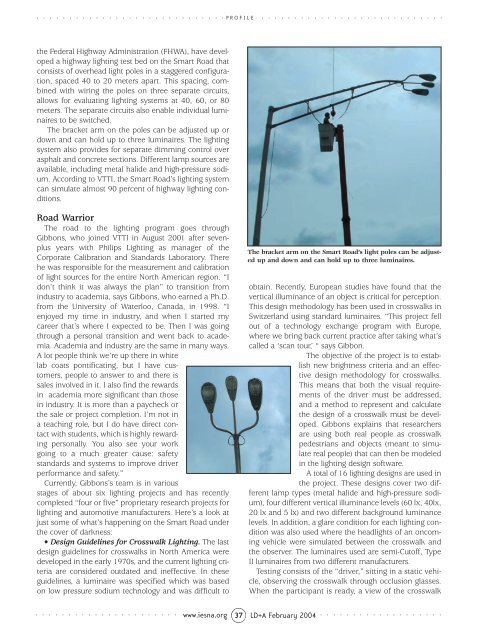april 000001 - Illuminating Engineering Society
april 000001 - Illuminating Engineering Society
april 000001 - Illuminating Engineering Society
Create successful ePaper yourself
Turn your PDF publications into a flip-book with our unique Google optimized e-Paper software.
. . . . . . . . . . . . . . . . . . . . . . . . . . . . . . . . . . . . . . . . . . . . . . . . . . . . . . . . . . . . . .P R O F I L Ethe Federal Highway Administration (FHWA), have developeda highway lighting test bed on the Smart Road thatconsists of overhead light poles in a staggered configuration,spaced 40 to 20 meters apart. This spacing, combinedwith wiring the poles on three separate circuits,allows for evaluating lighting systems at 40, 60, or 80meters. The separate circuits also enable individual luminairesto be switched.The bracket arm on the poles can be adjusted up ordown and can hold up to three luminaires. The lightingsystem also provides for separate dimming control overasphalt and concrete sections. Different lamp sources areavailable, including metal halide and high-pressure sodium.According to VTTI, the Smart Road’s lighting systemcan simulate almost 90 percent of highway lighting conditions.Road WarriorThe road to the lighting program goes throughGibbons, who joined VTTI in August 2001 after sevenplusyears with Philips Lighting as manager of theCorporate Calibration and Standards Laboratory. Therehe was responsible for the measurement and calibrationof light sources for the entire North American region. “Idon’t think it was always the plan” to transition fromindustry to academia, says Gibbons, who earned a Ph.D.from the University of Waterloo, Canada, in 1998. “Ienjoyed my time in industry, and when I started mycareer that’s where I expected to be. Then I was goingthrough a personal transition and went back to academia.Academia and industry are the same in many ways.A lot people think we’re up there in whitelab coats pontificating, but I have customers,people to answer to and there issales involved in it. I also find the rewardsin academia more significant than thosein industry. It is more than a paycheck orthe sale or project completion. I’m not ina teaching role, but I do have direct contactwith students, which is highly rewardingpersonally. You also see your workgoing to a much greater cause: safetystandards and systems to improve driverperformance and safety.”Currently, Gibbons’s team is in variousstages of about six lighting projects and has recentlycompleted “four or five” proprietary research projects forlighting and automotive manufacturers. Here’s a look atjust some of what’s happening on the Smart Road underthe cover of darkness:• Design Guidelines for Crosswalk Lighting. The lastdesign guidelines for crosswalks in North America weredeveloped in the early 1970s, and the current lighting criteriaare considered outdated and ineffective. In theseguidelines, a luminaire was specified which was basedon low pressure sodium technology and was difficult toThe bracket arm on the Smart Road’s light poles can be adjustedup and down and can hold up to three luminaires.obtain. Recently, European studies have found that thevertical illuminance of an object is critical for perception.This design methodology has been used in crosswalks inSwitzerland using standard luminaires. “This project fellout of a technology exchange program with Europe,where we bring back current practice after taking what’scalled a ‘scan tour,’ “ says Gibbon.The objective of the project is to establishnew brightness criteria and an effectivedesign methodology for crosswalks.This means that both the visual requirementsof the driver must be addressed,and a method to represent and calculatethe design of a crosswalk must be developed.Gibbons explains that researchersare using both real people as crosswalkpedestrians and objects (meant to simulatereal people) that can then be modeledin the lighting design software.A total of 16 lighting designs are used inthe project. These designs cover two differentlamp types (metal halide and high-pressure sodium),four different vertical illuminance levels (60 lx, 40lx,20 lx and 5 lx) and two different background luminancelevels. In addition, a glare condition for each lighting conditionwas also used where the headlights of an oncomingvehicle were simulated between the crosswalk andthe observer. The luminaires used are semi-Cutoff, TypeII luminaires from two different manufacturers.Testing consists of the “driver,” sitting in a static vehicle,observing the crosswalk through occlusion glasses.When the participant is ready, a view of the crosswalk. . . . . . . . . . . . . . . . . . . . . . . www.iesna.org . . . . . . . . 37. . LD+A . . . February . . . . 2004 . . . . . . . . . . . . . . . . . . . . . .
















